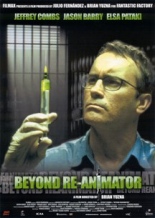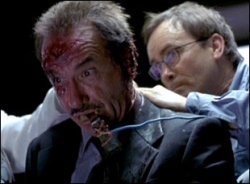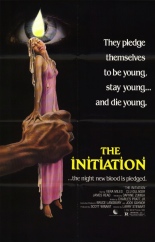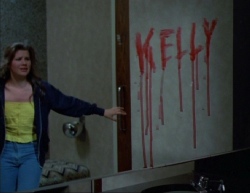
 Why doesn’t this turd have the words National Lampoon in its title? What sort of incriminating photos did the producers have of Cuba Gooding Jr.? Can the Academy for Motion Picture Arts and Sciences rescind the awarding of Oscars? And most importantly, why did I have to see if this really as bad as everyone says it is? Because it’s worse.
Why doesn’t this turd have the words National Lampoon in its title? What sort of incriminating photos did the producers have of Cuba Gooding Jr.? Can the Academy for Motion Picture Arts and Sciences rescind the awarding of Oscars? And most importantly, why did I have to see if this really as bad as everyone says it is? Because it’s worse.
Any movie in which a character lip-synchs and dances to James Brown’s “I Feel Good” should be thrown in cinematic jail for life, but Boat Trip keeps piling on offenses, like doing a Chariots of Fire parody (those ceased being funny in 1983), giving Saturday Night Live’s Horatio Sanz a starring role, having Cuba dry-hump a porthole until he jizzes on a guy’s face, and having Roger Moore suggestively lick weenies, among other things.
 The story (with apologies to the word “story”) has Gooding brokenhearted after his girlfriend (Vivica A. Fox) dumps him when he barfs on her cleavage and proposes marriage. To cheer him up, his ultra-horny janitor pal Sanz convinces him to accompany him on a cruise to engage in lots of promiscuous sex with loose women. But unbeknownst to them, a vengeful travel agent (Will Ferrell, whose cameo is the film’s only saving grace, outside of Victoria Silvstedt’s purple panties) books them on an all-male, all-gay ship. Let the homophobia ensue!
The story (with apologies to the word “story”) has Gooding brokenhearted after his girlfriend (Vivica A. Fox) dumps him when he barfs on her cleavage and proposes marriage. To cheer him up, his ultra-horny janitor pal Sanz convinces him to accompany him on a cruise to engage in lots of promiscuous sex with loose women. But unbeknownst to them, a vengeful travel agent (Will Ferrell, whose cameo is the film’s only saving grace, outside of Victoria Silvstedt’s purple panties) books them on an all-male, all-gay ship. Let the homophobia ensue!
The initially disgusted Sanz thinks the trip might be okay after all when he accidentally shoots down a Swedish bikini team’s helicopter with a flare gun and they must board, enabling them to suntan and do jumping jacks topless. Gooding, meanwhile, falls for the ship’s dance instructor, Rush Hour 2 hottie Roselyn Sanchez — who does things to a banana here that presumably killed her career — but he can’t reveal to her that he’s not a homosexual.
Despite all the cheap shots, the film actually does carry a “being gay is just fine” message, but I doubt very many could make it that far. Its humor is absolutely infantile, and the look suggests a cheap, made-for-cable comedy that wouldn’t get watched without gratuitous nudity. —Rod Lott


 H.P. Lovecraft’s demented Dr. Herbert West made a third house call with the long-overdue
H.P. Lovecraft’s demented Dr. Herbert West made a third house call with the long-overdue  I’ll admit I harbored strong reservations about Beyond; the fact that it was shot in Spain, set in a prison, scripted by a first-timer and had no principals return except Combs combined to portend an idea whose time had long passed. Plus, director Brian Yuzna’s spotty filmography —
I’ll admit I harbored strong reservations about Beyond; the fact that it was shot in Spain, set in a prison, scripted by a first-timer and had no principals return except Combs combined to portend an idea whose time had long passed. Plus, director Brian Yuzna’s spotty filmography — 
 That’s comprised mostly of one guy (George Diamond) who looks like Joe Mantegna’s second cousin. He’s trained in “subversive activities” and must find Prince Radolpho’s computer terminal. To do this, he’s given some gadgets that look assembled from various cast-off parts in Radio Shack’s bargain bin. This film’s Q rattles them off: “a rotational axis with combined sensor … and last but not least, your acid pen.” Replies our hero, “I hope it doesn’t leak in my pocket!”
That’s comprised mostly of one guy (George Diamond) who looks like Joe Mantegna’s second cousin. He’s trained in “subversive activities” and must find Prince Radolpho’s computer terminal. To do this, he’s given some gadgets that look assembled from various cast-off parts in Radio Shack’s bargain bin. This film’s Q rattles them off: “a rotational axis with combined sensor … and last but not least, your acid pen.” Replies our hero, “I hope it doesn’t leak in my pocket!”
 Whether you call it Thriller: A Cruel Picture, Hooker’s Revenge or
Whether you call it Thriller: A Cruel Picture, Hooker’s Revenge or  Frigga quickly learns the consequences of rebellion when her pimp punishes her by plunging a scalpel into her right eye (earning her both the nickname described in one the film’s alternate titles and a reason to sport a series of stylish patches). Instead of breaking her spirit, however, this only inspires her to secretly charge her “clients” extra to do the really dirty shit (which, by today’s Internet porn standards, admittedly doesn’t seem so bad) and use the cash to buy her own drugs, and train with experts in the fine arts of ass-kicking until she’s ready to proclaim her independence and properly exhibit her (extremely justified) dissatisfaction.
Frigga quickly learns the consequences of rebellion when her pimp punishes her by plunging a scalpel into her right eye (earning her both the nickname described in one the film’s alternate titles and a reason to sport a series of stylish patches). Instead of breaking her spirit, however, this only inspires her to secretly charge her “clients” extra to do the really dirty shit (which, by today’s Internet porn standards, admittedly doesn’t seem so bad) and use the cash to buy her own drugs, and train with experts in the fine arts of ass-kicking until she’s ready to proclaim her independence and properly exhibit her (extremely justified) dissatisfaction.
 Based on my fondness for HB2M (which I would happily list among my top five slashers), you’d think this would cause me to dismiss The Initiation as an unworthy copycat, but it’s actually a pretty decent flick, despite its lack of originality. The principal reason: a script that takes pains to develop real, likable characters who we sympathize with, which makes it something of a revelation in a genre where it’s normal for everyone other than the lone female protagonist to be an asshole who needs to die.
Based on my fondness for HB2M (which I would happily list among my top five slashers), you’d think this would cause me to dismiss The Initiation as an unworthy copycat, but it’s actually a pretty decent flick, despite its lack of originality. The principal reason: a script that takes pains to develop real, likable characters who we sympathize with, which makes it something of a revelation in a genre where it’s normal for everyone other than the lone female protagonist to be an asshole who needs to die.